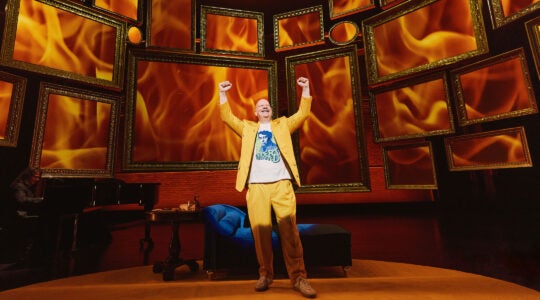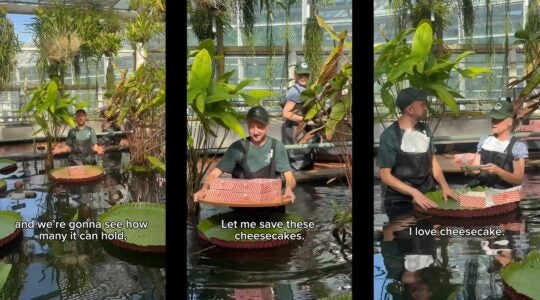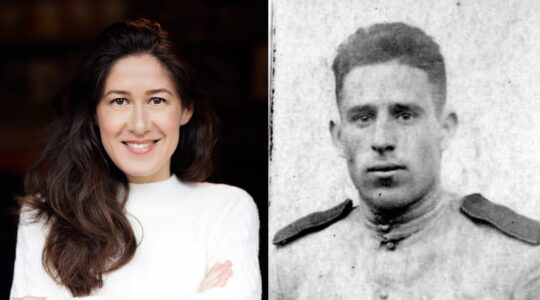Jack Goldfarb’s first memories of Staszow were second-hand. As a child in Philadelphia, the son of immigrants, he heard his parents’ stories, in Yiddish, about landsmen in Staszow. He heard about heroic relatives in that market town in south-central Poland who defied the Nazis during World War II and paid with their lives. He heard about the postcards with news of the mishpocha crammed in tiny Yiddish letters that would arrive several times a year, until the war started. He saw the family photographs, sepia portraits of Uncle Aron and Aunt Deborah and Cousin Chaskell in a picture album.
Staszow, a shtetl on the road between Kielce and Sandomierz, was home to Jews, tailors and hat makers and goldsmiths from the early 1700s until the Holocaust left it judenrein. The Goldfarbs and the Wolmans had lived there for two centuries.
Goldfarb, a freelance travel writer living in Manhattan, thought one day he would see Staszow with his own eyes, walk where his parents had walked, say Kaddish where his grandparents were buried.
He has realized his dream, and he continues to pay his respect to Staszow’s lost Jews by singlehandedly renovating its 175-year-old Jewish cemetery, his grandparents’ resting place. In the past 10 years, independent of the Jewish establishment, Goldfarb has spent his own funds (in the high-five figures) on his project. He has negotiated with officials ranging from the mayor of Staszow to the German embassy in Warsaw.
And this week, the latest chapter opens: workers in the cemetery are constructing a pair of memorial walls that feature the remnants of 400 Jewish gravestones that were serendipitously uncovered three years ago in a Staszow courtyard.
"I wanted to do it out of memory of the people," said Goldfarb, sitting in his East Side apartment that bears the carvings, photographs and artwork from the 110 countries he has visited during his career. "Every time I go to Poland, I go to Staszow."
Thirty-five members of his family died in the Holocaust.
What Goldfarb is doing is "terrific," says Ernest Michel, executive vice president emeritus of UJA-Federation and chairman of the 1981 World Gathering of Jewish Holocaust Survivors in Israel. "It’s very commendable. It’s a personal gesture to pay tribute to his family."
Goldfarb’s crusade grew out of his first visit to Poland, on business, in 1958. He spent a few hours in his family’s ancestral hometown and has returned nearly a score of times.
Goldfarb, of "indeterminate age," also arranged for the erection of a plaque at the site of the Staszow synagogue that survived the German occupation and was torn down in 1952.
On one trip he found that the town’s original Jewish cemetery "was gone," replaced without a trace by a playground. The newer Jewish cemetery, on a tree-lined hill two-thirds of a mile from the center of Staszow, was an open, empty lot, devoid of the gravestones that had been carted away by the Nazis for use as paving stones on muddy roads and sold to a construction company by municipal authorities after the war when no Jews returned to claim them.
"I knew that was the place where my grandparents and where my ancestors were buried," Goldfarb said.
So he paid to have the grounds spruced up, to have a metal fence built around the area, to have a 10-foot Holocaust memorial constructed, to have some 155 Jewish gravestones he discovered in Staszow homes brought back to the cemetery, to have a marker set up at a Shoah-era mass grave and to have the remains of three putative Staszow Jews who perished during World War II interred.
For Goldfarb, his commitment to the memory of Staszow’s Jews means annual trips to Poland to monitor his projects _ without the formal support of American Jewish organizations, with whom he has cordial relations.
"I found them all bureaucratic," he said. "It’s all on my own."
For those who lost relatives in the Holocaust, a Jewish cemetery in the old country is sometimes their only connection to their loved ones, Ernest Michel says.
"I can fully understand why they want to be sure that there is some monument to their families," he said.
Other Holocaust survivors or descendants of survivors have, like Goldfarb, taken it upon themselves to renovate Jewish cemeteries throughout Eastern Europe, as well as parts of Germany and the former Soviet Union.
In Poland, home to the world’s largest Jewish community before the war, "there are thousands of cemeteries in little villages [that] have been taken over by shrubs," Michel says.
Local municipalities, without financial aid from overseas Jews, cannot afford to maintain the cemeteries, he adds. "The money would be unbelievably high."
Such American-based organizations as the Committee for the Preservation of U.S. Heritage Abroad, Warsaw’s Citizens’ Committee for the Protection of Cemeteries and Monuments of Jewish Culture in Poland, and landsmanschaft groups from individual communities often underwrite cemetery repairs in the region.
For Goldfarb, it began when he saw the cemetery in disrepair. "I don’t plan anything," he says of his Staszow activities. "Every time I go, something new shows up."
After communism fell, when his restoration dreams became possible, Goldfarb negotiated with the mayor of Staszow, responsible for the cemetery site. He also engaged a local architect, who designed the concrete-granite Holocaust memorial, which features a Magen David and an inscription in Hebrew, English and Polish.
Five-thousand Jews, half the population of Staszow, lived there on the eve of the war; 90 percent died in the Holocaust. None have lived there since.
About 400 people attended the dedication of the memorial on Nov. 8, 1992, the 50th anniversary of the date of which the Jews in the Staszow ghetto were deported.
"There were only two Jews present" at the ceremony, Goldfarb recalls: himself and a poet from Lodz.
In subsequent years, 10 Jewish gravestones turned up in the gardens and backyards of Staszow residents. Goldfarb had them taken back to the cemetery. "A symbolic minyan," he calls them.
Then, three years ago, about to leave for Poland, Goldfarb was called by a friend in Israel who had recently visited Staszow. The friend had seen another Jewish gravestone in the courtyard of a schoolteacher whose home had been Gestapo headquarters a half-century ago.
"Why don’t you take a look?" the friend suggested.
Goldfarb visited the teacher. The gravestone was propped against a wall. "It was dusk, misty." Goldfarb looked at the Hebrew inscription. "It was my grandfather," he said, his eyes filling with tears.
The next morning his grandfather’s gravestone was back in the cemetery under the shade of an acacia tree.
"I said Kaddish," Goldfarb said. On that rainy day, he said, the clouds parted and a shaft of light shone on the cemetery for a half hour.
The voice of his grandfather was speaking through the miraculous discovery of the gravestone, Goldfarb says. "This was a message from him, to go on doing what I was doing, to keep renovating the cemetery."
Another 145 gravestones eventually were uncovered in the teacher’s courtyard, near the 400 shards from other markers that are being turned into the pair of memorial walls in the cemetery, side by side separated by the Holocaust monument.
Goldfarb later contacted the German Embassy in Warsaw, which agreed to pay $5,000 toward carrying the gravestones from the courtyard. "We all know how they got there," he said.
Goldfarb will return to Staszow this fall for the dedication of his latest projects.
"I feel it’s an obligation," he said. "It preserves the memory of the entire Jewish community."
Now Goldfarb’s memories of Staszow are first-hand. And, he says, other Jews with a connection to Europe’s shtetls can emulate him.
"If people took the initiative," he said, "they could all do the same."
The New York Jewish Week brings you the stories behind the headlines, keeping you connected to Jewish life in New York. Help sustain the reporting you trust by donating today.




